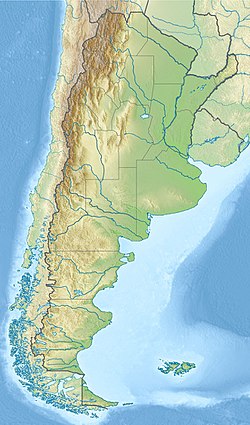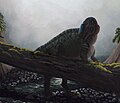Top Qs
Timeline
Chat
Perspective
Allen Formation
Geological formation in Argentina From Wikipedia, the free encyclopedia
Remove ads
The Allen Formation is a geological formation in Argentina whose strata date back to the Late Cretaceous (middle Campanian to early Maastrichtian.[1] Dinosaur remains are among the fossils that have been recovered from the formation.[2] Indeterminate chelid remains and other vertebrates have also been discovered in this formation.[3]
Remove ads
Description
Summarize
Perspective

Uliana and Dellapé defined the formation's stratotype in 1981 in the eastern area of the Bajo de Añelo, where the relation between the base and top is clearly exposed. The deposits are mostly clastic, interbedded with banks of limestone and layers of anhydrite, which were defined as continental and shallow marine facies associated with semiarid conditions.[4]
The interpreted sedimentary paleoenvironments range from purely continental such as ephemeral lacustrine, aeolian and fluvial systems to coastal marine paleoenvironments with development of estuaries and tidal flats, followed by a lagoon sedimentary stage from marsh to sea with carbonate precipitation in an area protected from waves, ending with a retraction leading to the accumulation of evaporites.[4]
Armas and Sánchez performed a detailed facies analysis of the formation in 2015, where the authors concluded the formation represents a hybrid coastal system of tidal flats, dominated by Atlantic ingressions, with a large storm influence in some areas linked to aeolian systems.[5]
A study of pollen found in outcrops of the middle member of the Allen Formation supported a late Maastrichtian age for these layers.[6]
Remove ads
Fossil content
Summarize
Perspective

Dinosaurs
Color key
|
Notes Uncertain or tentative taxa are in small text; |
Dinosaur eggs are known from the formation.[7]
Ornithischians
- Ankylosaurs
- Hadrosaurs
Saurischians
- Sauropods
Theropods
Pterosaurs
Fragmentary fossils are known from the formation.[7]
Fish
Squamata
Turtles
Rhynchocephalia
Plesiosauria
Frogs
Unnamed frogs belonging to the family Calyptocephalellidae and Leptodactylidae, and those with no family designation were also found.[28][3]
Mammals
The mammal fauna of the Allen Formation is known from seven teeth, which document the presence of several species.[31]
Plants
Remove ads
See also
References
Further reading
Wikiwand - on
Seamless Wikipedia browsing. On steroids.
Remove ads















